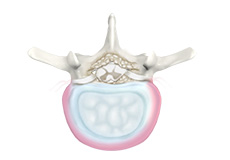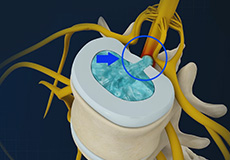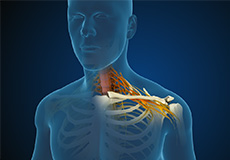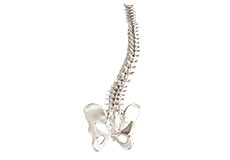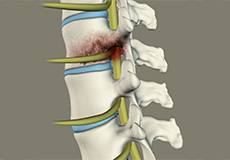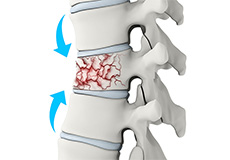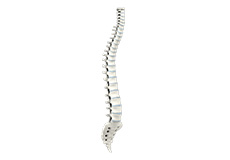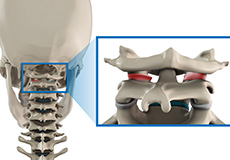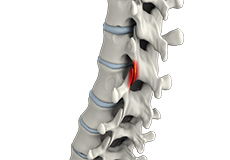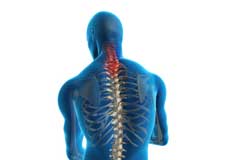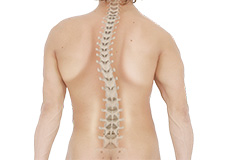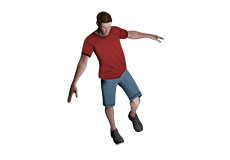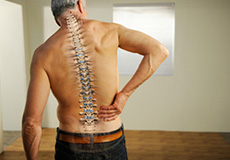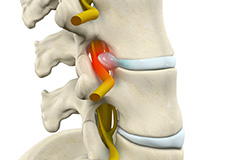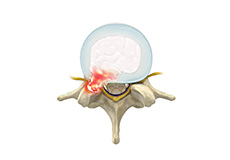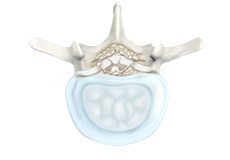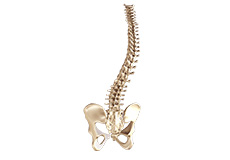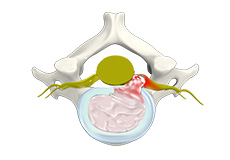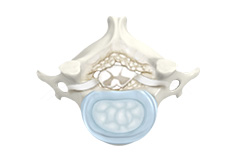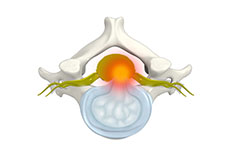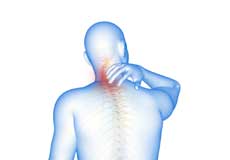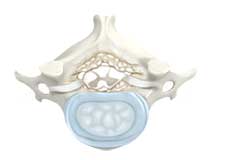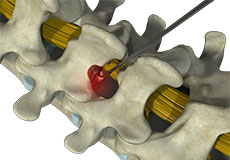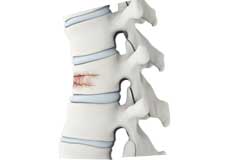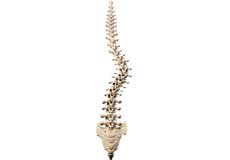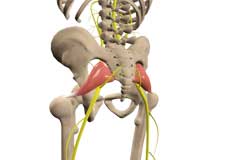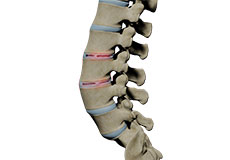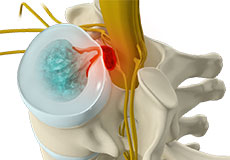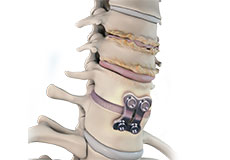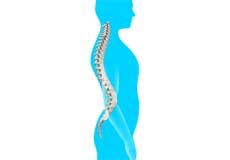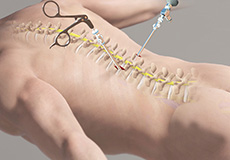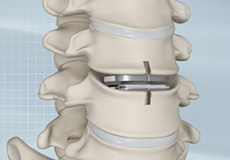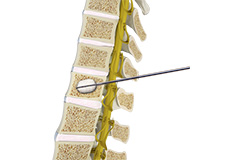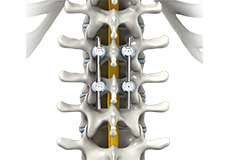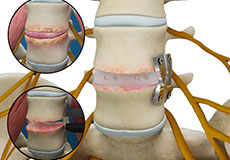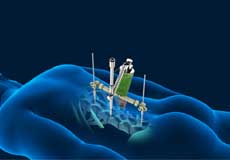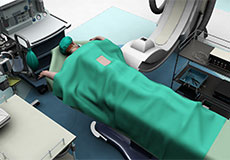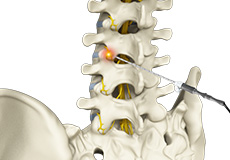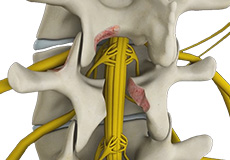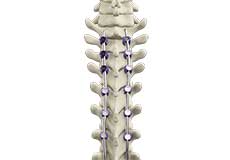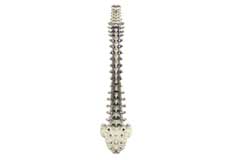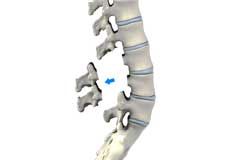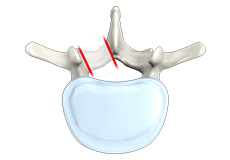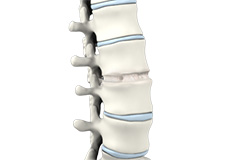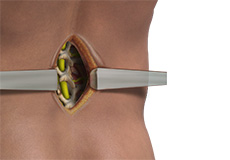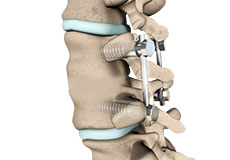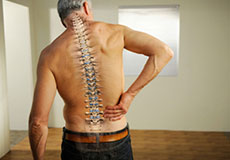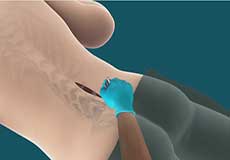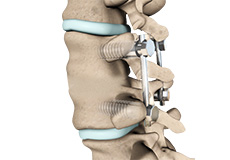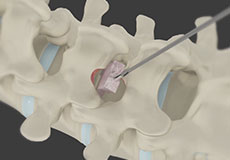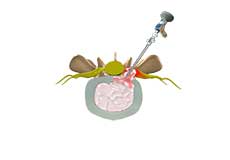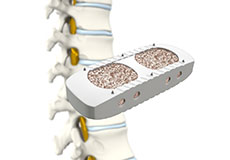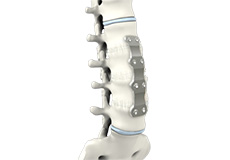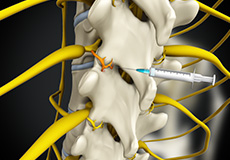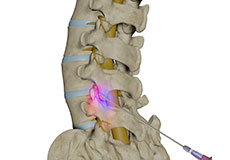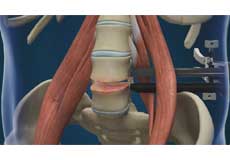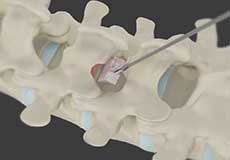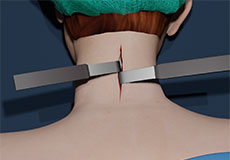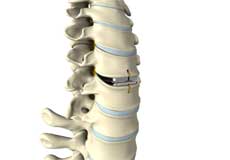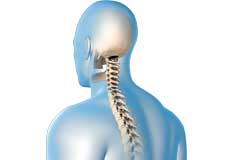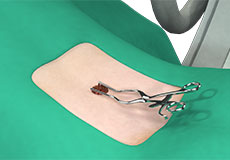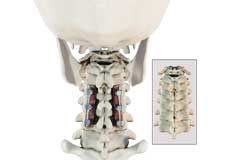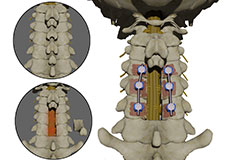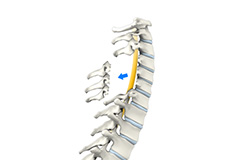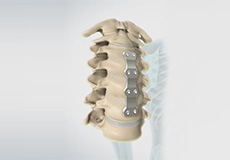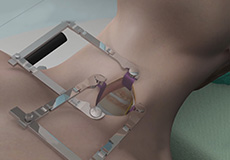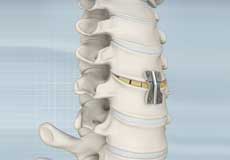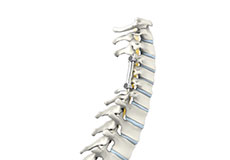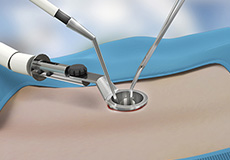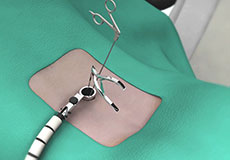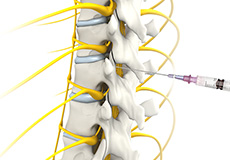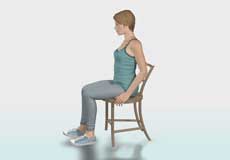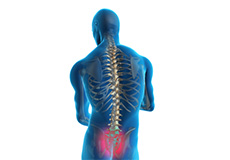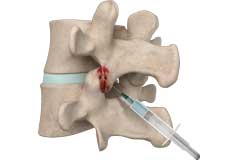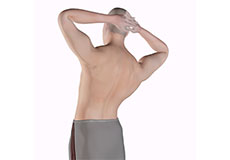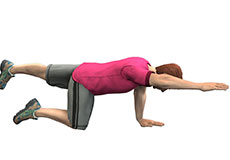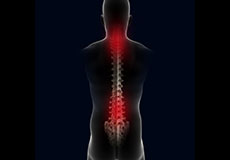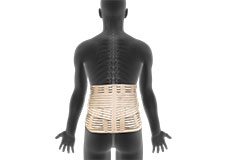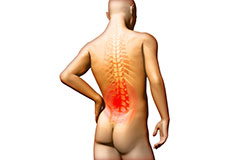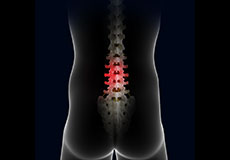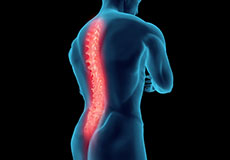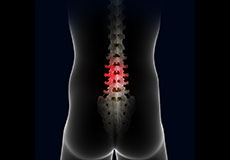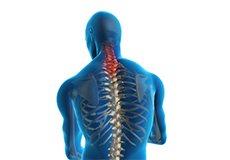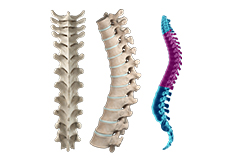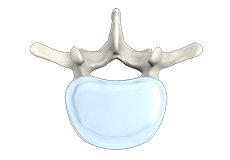Degenerative Disc Disease
Degenerative disc disease (DDD) refers to the gradual deterioration of the intervertebral discs between the vertebrae.
Spinal Stenosis
Spinal stenosis is a condition caused by the vertebral column constricting and exerting pressure on the spinal cord or neural foramen (a bony tunnel through which a nerve exits the spinal cord).
Spondylolisthesis
Spondylolisthesis is the displacement of the vertebral disc from the spinal column. Outward (forward) displacement is termed as anterolisthesis and inward (backward) displacement is termed as retrolisthesis.
Disc Herniation
Disc herniation is a condition where the central nucleus pushes through the outer edge of the disc, causing a bulge that compresses the spinal nerves.
Radiculopathy
Certain diseases or mechanical compression of these spinal nerves due to deformities in the vertebral column can lead to radiculopathy.
Cervical Radiculopathy/Myelopathy
Disc protrusion, also called herniated disc, is a condition caused by a tear in an intervertebral disc, allowing the disc contents to bulge out.
Spine Deformities
The spine or backbone provides stability to the upper part of our body. It helps to hold the body upright. It consists of a series of irregularly-shaped bones appearing in a straight line. The spine has two gentle curves, when viewed from the side and appears to be straight when viewed from the front. When these curves are exaggerated, pronounced problems can occur such as back pain, breathing difficulties and fatigue.
Spinal Infection
A spinal infection is described as an infection of the spine. It can occur in various locations of the spine i.e., intervertebral disc space, vertebral column, spinal canal, and nearby soft tissues.
Spinal Compression Fractures
A compression fracture of the vertebra occurs when the bones of the spine (vertebrae) collapse. Most commonly, these fractures occur in the thoracic or the middle portion of the spine.
Osteoporosis of the Spine
Osteoporosis is a bone disease characterized by a decrease in bone mass and density resulting in brittle, fragile bones that are more susceptible to fractures.
Low Back Pain
Low back pain is often a common symptom of many disease conditions and the back pain may range from simple or dull pain to sudden and sharp pain.
Spinal Fractures
Vertebral compression fractures occur when the normal vertebral body of the spine is squeezed or compressed. The bone collapses when too much pressure is placed on the vertebrae, resulting in pain, limited mobility, loss of height, and spinal deformities.
Spine Disorders
The spine is made up of a column of small bones called vertebrae that surround and protect the spinal cord and nerves that branch out from the spinal cord.
Spinal Instability
Spinal instability refers to the condition of failure of the spinal column to maintain its normal structure. Normally, the spine functions to protect and provide support to the body and its internal organs.
Facet Joint Arthritis
Facet joints, also called zygapophyseal joints, are synovial joints located at the back of your spine, connecting the vertebrae together. Normally the facet joints are lined by a cartilage and a membrane of synovium.
Neck Strains and Sprains
The neck is the most flexible part of the spine and supports the weight of the head. The unique anatomical structure of the cervical vertebrae allows the free movement of the head.
Poor Balance
Poor balance can be defined as a sense of unsteadiness on your feet due to dizzy spells or lightheadedness, fainting, blackouts, or loss of consciousness.
Neck Pain
Common neck pain may occur from muscle strain or tension from everyday activities including poor posture, prolonged use of a computer and sleeping in an uncomfortable position.
Spinal Injuries at Work
Injuries at the workplace are very common and may be debilitating. Global statistics report that around 260 million non-fatal injuries occur every year around the world of which 350,000 cases may suffer death.
Lumbar Radiculopathy
Back pain is a common condition affecting approximately 80% of the population at some point in their lives. The area usually affected is the lower back (lumbar region) as it bears most of the upper body’s weight.
Lumbar Herniated Disc
A herniated disc is a condition in which the outer fibers (annulus) of the intervertebral disc are damaged, causing the soft inner material of the nucleus pulposus to rupture out of its space.
Lumbar Stenosis
Lumbar stenosis is the compression of spinal nerves caused by the narrowing of the spinal canal. It is one of the common causes of lower back pain. Spinal stenosis can also affect the spine in the neck region.
Lumbar Degenerative Disc Disease
Lumbar degenerative disc disease (DDD) is a common cause of lower back pain. Over time, these natural shock absorbers wear out and degenerate.
Lumbar Disc Herniation
Lumbar disc herniation is the most common cause of lower back pain and leg pain (sciatica). Aging, injury or trauma may cause the annulus fibrosus to tear, resulting in protrusion of the nucleus pulposus.
Lumbar Facet Joint Arthropathy
A joint is a place where two bones contact each other. Arthropathy means any disease of the joints. Lumbar facet joint arthropathy occurs when the facet joints degenerate or wear out over time due to aging or arthritis.
Cervical Deformities
The spine is made up of 33 small bones called vertebrae and is known as the spinal column or vertebral column. It can be divided into 5 parts: cervical, thoracic, lumbar, sacral, and coccyx region.
Cervical Herniated Disc
Herniation of a disc is an anomalous spine condition characterized by the bulging of the inner contents of the intervertebral disc due to cracks in its outer wall.
Cervical Stenosis
Cervical stenosis refers to the narrowing of the spinal canal that protects the spinal cord and its branching nerves.
Cervical Disc Protrusion
Cervical disc protrusion, commonly known as a disc bulge, occurs when the spinal discs and associated ligaments are intact, but may form an outpouching that presses on the spinal nerves
Cervical Spondylosis
Cervical spondylosis, also called arthritis of the neck, is an age-related medical condition characterized by deterioration of spinal joints, vertebrae, discs, and ligaments in your neck.
Cervical Degenerative Disorder
Cervical degenerative disc disease (DDD) is a misnomer as it is not a disease but a condition that affects the strength, resiliency and structural integrity of the intervertebral discs due to increasing age, trauma, injury, repetitive movement, improper posture, or poor body mechanic
Cervical Disc Herniation
Cervical disc herniation can arise due to aberrations of the intervertebral disc such as bulging, rupture, and slipped or extruded disc. It results in neck, shoulder, and arm pain.
Cervical Degenerative Disc Disease
Cervical degenerative disc disease (DDD) is a misnomer, as it is not a disease as such but a condition that affects the strength, resiliency and structural integrity of the intervertebral discs due to increasing age, trauma, injury, repetitive movement, improper posture, or poor body mechanics.
Microdiscectomy
The spine is made up of small bony segments called vertebrae. These vertebrae are categorized into cervical or neck vertebrae, thoracic or upper back vertebrae, lumbar or lower back vertebrae and the sacrum within the pelvis.
Vertebral Compression Fractures
Back pain is an indication of stress fractures known as vertebral compression fractures. Vertebral compression fractures occur when the normal vertebral body of the spine is squeezed or compressed.
Whiplash
Whiplash is a soft tissue injury to the neck, usually caused by a sudden forceful jerk commonly occurring because of an automobile accident, sports injuries or an accidental fall. Headache may develop immediately or after a short period of time after the injury. Sometimes, whiplash may also be referred to as neck strain, neck sprain or hyperextension injury.
Adult Degenerative Scoliosis
Adult degenerative scoliosis is characterized by side to side or lateral bending of the spine in adults. Degenerative scoliosis can involve either the mid-back and/or lower back region of the spine.
Piriformis Syndrome
Piriformis Syndrome is an uncommon, rare neuromuscular condition caused by the compression of the sciatic nerve by the piriformis muscle.
Disc changes
The cartilaginous disc is made up of an outer fibrous layer called the annulus fibrosus, which surrounds an inner gelatinous core called the nucleus pulposus.
Cauda Equina Syndrome
What Cauda equina syndrome is an emergency condition characterized by persistent severe lower back pain caused by the compression of a bundle of spinal nerves (cauda equina) at the end of the spinal cord (lower back and hip region). If not treated promptly, it can lead to permanent paralysis of the legs, or bowel, bladder, and sexual problems.
Adjacent Segment Disc Disease
Spinal fusion surgery involves the fusion of two or more vertebral bones and is a standard of care for spinal deformities and conditions such as radiculopathy, myelopathy, and spondylolisthesis.
Arm Pain of Spinal Origin
Arm pain of spinal origin can be described as discomfort or pain felt anywhere in the arm including the wrist, elbow, or shoulder as a result of a pinched nerve (nerve compression) or irritated nerve in the spinal cord. The pain can occur as a dull constant pain or a sudden sharp pain that can develop suddenly or over time.
Isthmic spondylolisthesis
Isthmic spondylolisthesis is a spinal disorder in which one vertebra glides forward over the vertebra below. It usually affects the lumbar (lower back) spine, more frequently at L5-S1 levels (the fifth lumbar vertebra and first sacral vertebra).
Minimally Invasive Spine Surgery
Minimally invasive spine surgery (MISS) is the latest technology available to perform spinal surgeries through small, less than one-inch-long incisions.
Microdiscectomy
The spine is made up of small bony segments called vertebrae. These vertebrae are categorized into cervical or neck vertebrae, thoracic or upper back vertebrae, lumbar or lower back vertebrae and the sacrum within the pelvis.
Cervical Disc Replacement
The cervical spine is located in the neck region and consists of seven bones arranged one on top of the other. Cushioning tissue called vertebral discs located between the vertebrae act as shock absorbers, allowing easy movement of the neck.
Kyphoplasty
Balloon kyphoplasty is a spine surgery that relieves back pain caused by a vertebral compression fracture. The aim of balloon kyphoplasty is to relieve pain, stabilize the fracture and restore the vertebral body height.
Spinal Fusion
Spinal fusion is the surgical technique of combining two or more vertebrae. A fusion of the vertebrae involves the insertion of secondary bone tissue obtained either from an autograft (tissues from your own body) or allograft (tissues from another person) to enhance the bone healing process.
Lateral Lumbar Interbody Fusion
The back is made up of a number of small bones called vertebrae. Cushioning discs present between the vertebrae act as shock absorbers.
Robotic Spine Surgery
Robotic spine surgery is a procedure where your surgeon is assisted by a robotic system to perform surgery to the spine. Precision is very important when performing spine surgery.
Kyphoplasty & Vertebroplasty
Osteoporosis is a “silent” disease characterized by the weakening of bones. This makes the patients more susceptible to fractures, typically in the hip and spine.
Revision Spinal Surgery
Revision spine surgery is surgery performed in certain patients to correct the problems of earlier spine surgery.
Radiofrequency Ablation
Radiofrequency ablation (RFA), also called rhizotomy or neurotomy, is a novel non-surgical technique of treating pain. This technique employs radiofrequency waves to produce heat and the heat produced damages the nerves transmitting pain signals to the brain.
Spinal Decompression
Spinal decompression is a treatment to relieve pressure on one or many “pinched nerves” in the spinal column. It can be achieved either surgically or by non-surgical methods.
Scoliosis Surgery
Surgery for scoliosis is recommended when the spinal curvature is severe and is either worsening or is a cause of severe pain or difficulty in breathing. The surgery is aimed at rectifying the spinal curvature, stabilizing the spine and preventing it from worsening.
Spine Deformity Surgery
The spine or backbone provides stability to the upper part of the body. It helps to hold your body upright. It consists of several irregularly-shaped bones called vertebrae appearing in a straight line.
Lumbar Laminectomy
Lumbar laminectomy, also known as decompression laminectomy, is a spinal surgery performed to relieve excess pressure on the spinal nerve(s) in the lumbar (lower back) region.
Lumbar Foraminotomy
A lumbar foraminotomy is a surgical procedure that decompresses the spinal nerves by removing bone and other tissues that obstruct the neural foramen.
Lumbar Fusion
Spinal fusion, also called arthrodesis, is a surgical technique used to join two or more vertebrae (bones) within the spine. Lumbar fusion is the procedure of fusing the vertebrae in the lumbar portion of the spine (lower back).
Lumbar Decompression
Lumbar decompression is a surgical procedure performed to relieve pressure over the compressed nerves in the lower spine (lumbar region).
Transforaminal Lumbar Interbody Fusion (TLIF)
Transforaminal lumbar interbody fusion (TLIF) is a type of spinal fusion procedure in which bone graft is placed between the affected vertebrae in the lower back (lumbar) region through an incision on the patient’s back.
Posterior Lumbar Fusion
Spinal fusion, also called arthrodesis, is a surgical technique used to join two or more vertebrae (bones) within the spine. Lumbar fusion is the fusion the vertebrae in the lumbar portion of the spine (lower back).
How to prevent Back Pain
Back pain is common and usually affects everyone at some point. It often occurs more frequently as you grow older. Pain can either be sharp and sudden or dull and constant. Acute back pain lasts a few days or weeks while pain that lasts more than 6 months is considered chronic. Adopting a few good habits and taking certain precautions can help prevent back pain.
Posterolateral Lumbar Fusion
Posterolateral lumbar fusion is a surgical technique that involves correcting spinal problems from the back of the spine by placing bone graft between segments in the back and leaving the disc space intact.
Lower Back (Lumbar) Surgery
Low back pain usually does not require surgery. However, surgery may be beneficial for persistent pain, spinal instability, weakness or numbness in the legs or feet, and impaired bowel or bladder function.
Lumbar Interbody Fusion
Lumbar interbody fusion (LIF) surgery is a surgical technique that involves the removal of a damaged intervertebral disc and the insertion of a bone graft into the disc space created between the two adjoining vertebrae.
Minimally Invasive Lumbar Discectomy
Lumbar discectomy is a spinal surgery that involves the removal of the damaged intervertebral disc(s) to relieve pressure on the spinal nerves (decompression) in the lumbar (lower back) region, which forms the lower portion of the spine and comprises of five vertebrae (L1-L5). A minimally invasive technique is implemented to perform the surgery.
Anterior Lumbar Interbody Fusion
Anterior lumbar interbody fusion (ALIF) is a surgery performed to correct spinal problems in the lower back. The surgery can be implemented either as an open surgery or minimally invasive technique.
Minimally Invasive TLIF
Transforaminal lumbar interbody fusion (TLIF) is a minimally invasive fusion of the vertebrae of the lumbar region (lower back). It is designed to provide stability to the spine and treat back and leg pain.
Lumbar Microdiscectomy
Microdiscectomy is a surgical procedure employed to relieve the pressure over the spinal cord and/or nerve roots, caused by a ruptured (herniated) intervertebral disc.
Lower Back Pain Surgery
Lower back pain can be disabling; however, most cases heal with time (2-12 weeks) and with conservative therapy. However, surgery is suggested when symptoms persist and begin to affect your daily activities.
Lumbar Spinal Fusion
The surgical technique of combining two or more vertebrae is known as spinal fusion. Back pain due to abnormal motion of the vertebrae is treated by this procedure.
Treatment Options for Back and Neck Pain
Back and neck pain is common symptoms of injury, damage, deformity, or unhealthy spinal conditions. Pain may range from a mild ache to a sharp shooting pain that can spread down your arms and legs. There are many conservative and surgical treatment options that can relieve pain by targeting the symptoms or the underlying problem.
XLIF - Extreme Lateral Interbody Fusion
Extreme lateral interbody fusion (XLIF) is a minimally-invasive surgery that involves the fusing of two degenerative spinal vertebrae. The procedure is conducted to relieve painful motion in the back caused by spinal disorders.
Anterior Lumbar Corpectomy and Fusion
Anterior Lumbar Corpectomy and Fusion is a surgical technique performed to remove the vertebral bone or disc material between the vertebrae to alleviate pressure on the spinal cord and spinal nerves (decompression) in the lumbar (lower back) region.
Lumbar Medial Branch Block
A medial branch block is a procedure in which a mixture of a local anesthetic with or without a corticosteroid is injected near the medial branch nerves supplying a facet joint.
Lumbar Facet Block
A facet block is a procedure in which a combination of a local anesthetic and a corticosteroid is injected into a facet joint. A lumbar facet block prevents the transmission of pain signals from the lower back.
Radiofrequency Ablation for Lumbar Spondylosis
Radiofrequency ablation for lumbar spondylosis is a minimally invasive surgical procedure performed to treat lower back pain secondary to lumbar spondylosis.
Lumbar Discectomy
A lumbar discectomy is a surgical procedure performed to treat a herniated or ruptured disc and relieve pressure on the spinal nerves.
Minimally Invasive Lumbar Fusion
Spinal fusion is a surgical technique used to join together two or more vertebrae in the spine and to minimize the pain caused by the movement of these vertebrae. The fusion of vertebrae in the lumbar portion of the spine is called lumbar fusion and the surgery can be done as an open or minimally invasive procedure.
Minimally Invasive Lumbar Decompression
Minimally invasive lumbar decompression or mild® is a procedure developed by Vertos Medical to treat lumbar spinal stenosis by relieving pressure on the spinal nerves.
Minimally Invasive Lumbar Surgery
Spinal surgery can be performed by two different approaches; one is the conventional open surgical approach and the other is the advanced minimally invasive approach.
Neck Surgery
Neck surgery is a surgical procedure employed for the treatment of neck pain when conservative measures such as physical rehabilitation, medications, and rest have failed to provide any relief to your neck pain.
Cervical Arthroplasty
Arthroplasty is a surgical procedure to restore joint function by replacing a damaged joint with an artificial joint called a prosthesis.
Complex Spine Surgery
Complex spine surgery is a procedure that involves six or more vertebrae of the spinal column, requiring six or more hours of surgery to correct a spinal deformity.
Outpatient Spine Surgery
Outpatient spine surgery is an operative procedure that does not require an overnight stay at the hospital. It is also called ambulatory or same-day surgery.
Cervical Spine Fusion
Cervical spine fusion is a surgery performed to fuse weak cervical vertebrae with adjacent vertebrae to provide stability and prevent injury to the spinal cord.
Posterior Cervical Fusion
Posterior cervical fusion (PCF), a surgical procedure performed through the back of the neck, involves joining or fusing two or more damaged cervical vertebrae.
Posterior Cervical Decompression
Posterior cervical decompression is a surgical procedure performed through the back of the neck to relieve pressure over compressed nerves in the cervical spine region caused by inflamed spinal tissue or nerves, by removing portions of the cervical vertebrae.
Posterior Cervical Laminectomy and Fusion
Posterior cervical fusion (PCF), a surgical procedure performed through the back of the neck, involves joining or fusing two or more damaged cervical vertebrae.
Anterior Cervical Corpectomy and Fusion
An anterior cervical corpectomy and fusion is an operative procedure to relieve pressure on the spinal cord and spinal nerves by removing the vertebral bone and intervertebral disc material (decompression) in the cervical spine or neck.
Artificial Cervical Disc Replacement
Artificial cervical disc replacement is a spine surgery to replace a degenerated (deteriorated) disc in the neck with an artificial disc. The artificial disc, like the natural healthy disc, is used to replace the degenerated disc.
Anterior Cervical Discectomy with Fusion
Anterior cervical discectomy with fusion is an operative procedure to relieve compression or pressure on nerve roots and/or the spinal cord due to a herniated disc or bone spur in the neck.
Multilevel Posterior Cervical Laminectomy and Fusion
Posterior cervical laminectomy and fusion is an operative procedure to relieve pressure or compression on the nerve structures due to herniated disc, spinal stenosis, or spondylosis. It is often performed for multilevel spinal cord compression from cervical spinal stenosis to decompress the spinal cord and nerve roots in the cervical region (neck region) of the spine.
Image-Guided Spine Surgery
Imaging techniques such as computed tomography and fluoroscopy may be integrated into the system to facilitate pre-operative planning of the surgery, where a series of images taken before the surgery are displayed on a screen, with which your surgeon matches his/her moves intraoperatively.
Minimally Invasive Discectomy and Decompression
The spinal cord passes through the vertebral column, which forms a bony protective cover. However, many conditions can cause parts of the vertebrae to compress the spinal cord or the nerves that branch out through them, leading to pain, loss of sensation and/or motor function in the part of the body supplied by the compressed nerve.
Adult Scoliosis Correction
Adult scoliosis is the abnormal curvature of the spine giving the spine an “S” or “C” shape in a skeletally mature person. Larger curves cause discomfort while smaller curves usually do not cause any problems.
Surgical Treatment for Spine Conditions
Surgical treatment is the last resort for chronic backache when other therapies do not relieve the pain. Some surgical procedures can be performed as an out-patient procedure while others may require hospital admission.
Minimally Invasive Spine Surgery for Spondylolisthesis
Spondylolisthesis is a condition of the spine characterized by the forward displacement of a vertebra over an underlying vertebra. A significant displacement can cause a compression of the spinal nerves resulting in pain.
Spine Injections
Spine injection is a non-surgical treatment modality recommended for the treatment of chronic back pain. Injection of certain medicinal agents relieves the pain by blocking the nerve signals between specific areas of the body and the brain.
Non-Surgical Treatment for Disc Disease
The spinal column consists of vertebral bones stacked one on top of the other, surrounding and protecting the spinal cord.
Sacroiliac Joint Injections
Sacroiliac joints (SI joint) are joints in the lower back region, located where the sacrum and ilium bones conjoin. Despite the fact that these joints are small and have limited motion, they have an important role in connecting your spine to the pelvic bone and thus the lower part of your body.
Caudal Epidural Injection
The epidural cavity is the space surrounding the spinal cord, which extends from the skull to the tailbone, and consists of fat, nerves and blood vessels. Nerves in this space can be blocked by injecting an anesthetic, or a constricted nerve can be relieved of pain and inflammation by injecting a steroid medication into the epidural space.
Epidural Spinal Injection
Epidural spinal injection is a non-surgical treatment option utilized for relieving back pain. Spine degenerative conditions such as herniated disc, spinal stenosis and many others may induce back pain due to the compression of the associated spinal nerves.
Transforaminal Epidural Steroid Injection
The epidural space of the spine is the area between the vertebral bones and the protective dura sac that surrounds the spinal cord and nerves.
Facet Injections
A minimally invasive treatment called facet injection offers symptomatic relief from back pain caused by inflammation of the facet joints; however, this is not a permanent solution for the condition.
Role of Medications in Back Pain
Medications play an effective role in the treatment of back or neck pain. Your doctor may prescribe several medications to help reduce pain and associated symptoms that are caused by unhealthy spinal conditions or deformities.
Back Pain Exercises
Strenuous activities of daily living can stress the back resulting in pain. It is natural at this time to withdraw from activity and rest, but is not helpful in the long run and may actually slow down the healing process.
Spine Rehabilitation
Dysfunction of the spine can be severely debilitating to one’s ability to perform activities at both home and work. Pain in the lumbar spine (lower back) is the number one reason for missed days of work, followed by the pain of the cervical spine (neck).
Nutrition and Your Spine
Nutrients are the chemical components present in food, which provide energy for carrying out normal physiological functions and aid in various metabolic processes of the body.
Healthy Back Tips
Back and neck pain is the most common health problems experienced by most people, at some point in their lives. People with back pain or neck pain may have trouble performing daily routine activities.
Back and Neck Braces
The spine is composed of spinal bones called vertebrae, intervertebral discs, connective tissue, and muscles. All of these structures provide support, stability, and mobility to the upper body.
Proper Lifting
Lifting heavy weights and improper lifting of weights is one of the foremost causes of neck pain or lower back pain. Practicing proper lifting techniques is essential to avoid strain on your neck and back.
Preventing Back Pain at Home and Work
The back is subject to wear and tear from daily activities and stresses. Pain may vary in severity and duration. Although the natural degenerative processes that take place with aging cannot be avoided, precautions can be taken at home and your workplace to minimize its impact.
Complications of Spinal Surgery
Possible complications may occur before surgery, during surgery, and after surgery.
Recovery and Post-op Instructions after Spine Surgery
The duration of hospitalization depends on the treatment rendered. The period of your rest or inactivity depends on a few factors such as the type of surgical procedure and the approach used to access your hip, the size of the incision and presence of any complications. Return to work or normal activity depends on the type of work or activity you plan to perform.
Spine Comprehensive Medicine
Spine comprehensive medicine involves comprehensive care of acute or chronic neck or back injuries or conditions. It aims at minimizing your pain, making you as functional as possible and preventing future injury.
Possible Complications of Spinal Surgeries
The most serious complication of a herniated disc that may occur before surgery is the development of the cauda equine syndrome. It occurs when a large particle of disc material is ruptured into the spinal canal.
Cervical Spine Anatomy
The spine can be divided into 4 parts: cervical, thoracic, lumbar and sacral region. The cervical spine comprises of the first 7 vertebrae, which form the neck.
Thoracic Spine Anatomy
The thoracic spine is the central part of the spine, also called the dorsal spine, which runs from the base of the neck to the bottom of your rib cage. The thoracic spine provides the flexibility that holds the body upright and protects the organs of the chest.
Lumbar Spine Anatomy
The spine also called the back bone, plays a vital role in stability, smooth movement and protection of the delicate spinal cord. It is made up of bony segments called vertebra with fibrous tissue called intervertebral discs between them.

